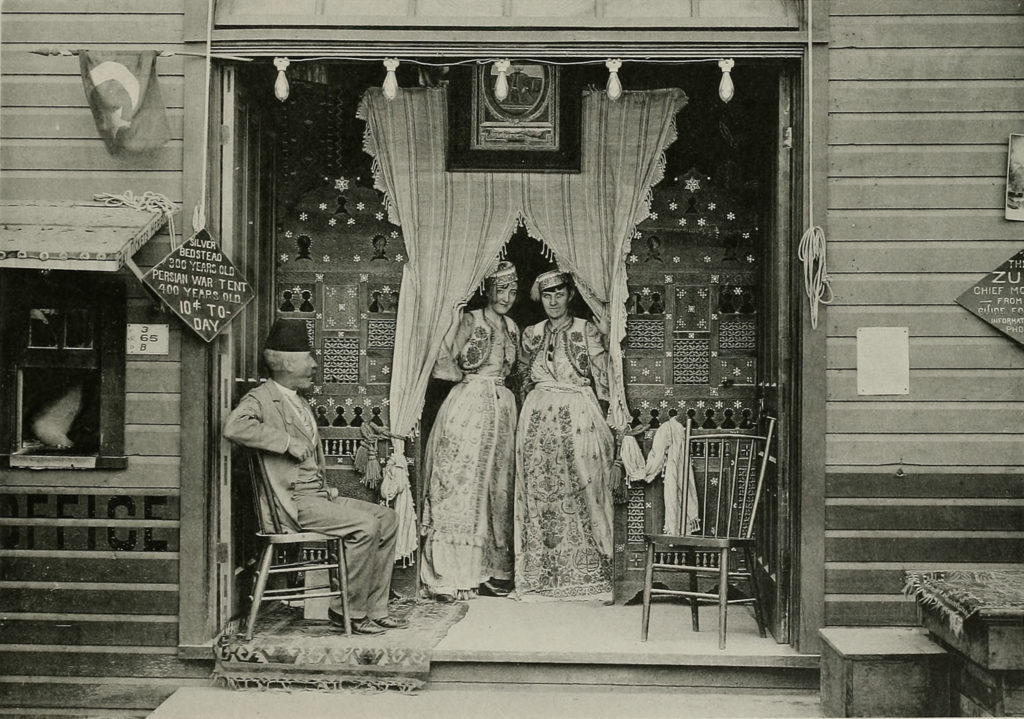Last time, we spent Rosh Hashanah with soldiers in 1918 France. Now we meet other Jews observing the holidays far from home: Ottoman Jews staffing the Turkish Village at the 1893 World’s Fair.
This description of their Yom Kippur services—published in 1901 but probably written earlier—reflects the exoticism that pervaded writings about the fair.

Entrance to the Turkish Village on the midway of the World’s Columbian Exposition in Chicago. Most of the village closed for Yom Kippur.
YOM KIPPUR ON THE MIDWAY
By Isidor Lewi
About four-fifths of the inhabitants of the Turkish village on the Midway Plaisance at the Chicago Exposition were Jews. Merchants, clerks, actors, servants, musicians, and even the dancing girls, were of the Mosaic faith, though their looks and garb would lead one to believe them Mohammedans. That their Judaism was not of the passive character was demonstrated by the closed booths, shops, and curio places, by the silence in the otherwise noisy theaters and the general Sabbath day air which pervaded the “Streets of Constantinople” on Yom Kippur—the Day of Atonement.
A more unique observance of the day never occurred in this country, and to the few Americans who had the good fortune to be present it presented a picture of rare beauty and solemnity.
The Turkish mosque was so arranged that it could be used as a Jewish house of worship also—the paraphernalia was all there and the Moslem is liberal enough to allow religious service other than his own to take place in his houses of worship—a point which he thinks the Western people would do well to ponder.
It was in this gorgeously equipped and dimly lighted mosque that the oriental Jews assembled on Tuesday evening, September 19, 1893, and read the Kol Nidra service. A screen of carved wood was placed across one corner of the mosque, and behind this the women, robed in white, with faces partially concealed behind white veils, worshiped. The men, gorgeous in varicolored silken garments, some wearing the simple fez and some the more elaborate turban, removed their shoes at the door before entering, and when they did not stand facing the East, where the cantor intoned the prayers, they sat cross-legged on the matted floor.
Each and every one had brought with him from his home the scarf which the orthodox Jew wears at prayer time and the Hebrew book of prayers. In the course of the ceremonial Mr. Robert Levy, the Ottoman concessionnaire, approached the altar and asked a blessing on the President of the United States and on the Sultan of Turkey. The services lasted long into the night, and when silence reigned all over the White City, when the robe of night and sleep covered the kaleidoscopic Midway, these Jews from the land of the Wise Men were still worshiping in the mosque.
On Wednesday, September 20, the mosque was too small to hold the worshipers, and a great bazaar, in which rugs and tapestries were on exhibition, was converted into a synagogue, and with its dark hangings, great banks of fantastic webs, its improvised altar and ark, against which the costumes of the Turks gained in brilliancy, looked even more picturesque than the mosque. Here again were the white-robed women, separated from the men by a man-high screen; here again the men in rich oriental costume, and except the few who came in full evening dress—which is nothing unusual at a day function in Turkey—no two were clad alike. They came from all parts of the Orient. Constantinople had the largest representation, though there were men from Adrianople, Tunis, Tripoli, Damascus, Smyrna, Bombay, Calcutta, from Algeria and other Eastern points, and two lone men from New York. And here it was seen how wise were those who made the Hebrew the language of prayer for the Jews. Coming from lands far apart, unfamiliar with one another’s language, unable to converse with one another in many instances, still in prayer, by the use of the same language, they were united.
In one corner, bent over his book of prayers, dressed in a brown silken robe and ample turban, stood the white-bearded, venerable “Faraway Moses” whom Mark Twain introduced to his readers years ago; at every turn stood or reclined a figure which might have been a Doré model. The fakir’s cries, the clang of cymbals, the din of tom-toms, the endless drone and buzz of hurrying thousands came from the wonderful street a few steps off; above these the strains of martial music from the German village across the way, and above all rose the chant of these strangely habited men and women: “Hear, O Israel! The Lord our God, the Lord is one.”
Text source: Report of the Committee on Awards of the World’s Columbian Commission (Washington: Government Printing Office, 1901).
The photo is from C. D. Arnold and H. D. Higinbotham, Official Views of the World’s Columbian Exposition (Chicago: Press Chicago Photo-Gravure, 1893).
